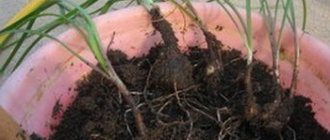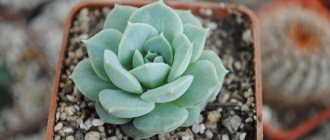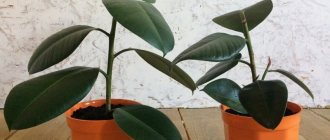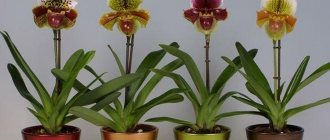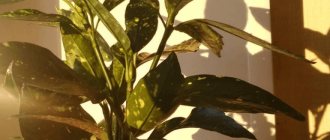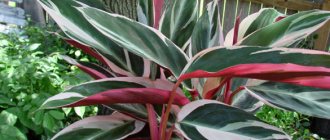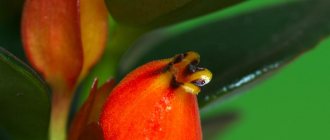A participant of our portal with the nickname Tsimlyanochka was the first in Moscow, and perhaps in Russia, to begin growing and promoting the most beautiful indoor tree - polyscias. The oldest plant in her collection is now 25 years old.
The oldest polyscinas from the Tsimlyanochka collection is the shrubby “Plumata”.
In this article we will look at:
- Types of polyscias recommended for indoor growing.
- Rules for cutting polyscias.
- Soil requirements for polyscias.
- Features of watering and maintenance conditions.
Brief description of cultivation
- Bloom . Grown as an ornamental foliage plant. Does not bloom indoors.
- Illumination . Green-leaved species grow in slight shade, while variegated ones grow in bright, diffused light.
- Temperature regime . In winter - from 17 to 20 degrees, during the growing season - from 20 to 23 degrees.
- Watering . During the spring-summer period, water the bush frequently, but moderately, immediately after the top layer of soil mixture in the pot has dried. And in winter, watering is reduced and carried out only after two or three days have passed after the top layer of the soil mixture has dried.
- Air humidity . She must be tall. Therefore, it is recommended to place the pot with the plant on a tray filled with wet pebbles, or it is necessary to systematically moisten the plant with a spray bottle.
- Fertilizer . Fertilizing is carried out in April–October twice a month, for this purpose they use mineral fertilizer for decorative deciduous plants. Moreover, from October to April, polyscias is fertilized half as often (once a month).
- Rest period . It is not pronounced, but in winter the flower grows more slowly.
- Transplant . In the last days of March or in the first days of April. While the bush is young, it is replanted regularly once a year. An older plant is replanted once every 2 or 3 years.
- Reproduction . By seeds, but much more often by apical or stem cuttings.
- Disease . Root rot.
- Pests . Aphids, root nematodes, scale insects and mealybugs.
Is polyscias suitable for bonsai formation?
Some varieties of polyscias are suitable for creating a bonsai tree. The flower grows very slowly, pruning can be done no more than 2-3 times a year. Step-by-step instruction:
- Remove unwanted, dry and deformed parts of the plant, as well as large leaves.
- Carry out maintenance pruning of the crown and branches; you can remove up to 20% of the total mass. The work should be carried out with special scissors; the cut location should be in the active growth zone.
- Align the shape so that the upper shoots are thinner than the lower ones.
After work, it is advisable to water the plant and treat the cut areas with a special paste to avoid drying out and the development of diseases. Immediately after shaping, it is necessary to apply wire to give the direction of growth to the branches.
Features of polyscias
The branched system of polyscias roots grows both horizontally and vertically. The heavily branching stems are covered with brownish bark. Over time, they become lignified, but they still remain very flexible: the stems are extremely difficult to break, but they can be tied into a knot and then straightened. As it grows, the lower part of the bush becomes exposed. Alternately arranged short-petioled leaf plates are painted in a rich or pale green color; they are round, lobed, triply pinnate or paired-pinnate, simply glossy or leathery. Polyscias has variegated varieties that are very popular among gardeners. While the bush is young, its foliage, as a rule, has a simple shape, but over the years it divides into segments. During flowering, inflorescences are formed on the bush, having a capitate or umbrella shape. But when cultivated indoors, such a plant blooms extremely rarely.
What is polyscias?!? )))) Poliscias fabian. Aralia fabian. My departure
Plant characteristics
- It looks like a small tree or a low bush. The branches are directed upwards.
- As it grows, a brown bark forms on the trunk. Despite this, the flexibility of the barrel is preserved. The branches bend and straighten easily, but are difficult to break.
- The leaves have a variety of shapes and colors. They are attached to the trunk by short petioles. The most popular are plants with variegated and carved leaves.
- Young polyscias have entire leaves. As they grow, they acquire a bizarre shape and carved edges.
- The older the tree gets, the more the plant resembles a bonsai, with no branches or leaves on the lower part of the trunk.
- A powerful root system, growing in width and depth, needs a voluminous pot.
Observing flowering when cultivated in an apartment will be an exception.
Caring for polyscias at home
Illumination
Poliscias, growing both in nature and at home, needs bright, diffused light. Moreover, it needs a large amount of light both in the warm season and in winter. This flower grows well even in slight shade. When choosing a location, it should be taken into account that green-leaved species grow normally in light partial shade, however, varieties with variegated foliage need a lot of light to maintain their bright color.
Temperature
This flower grows best during the growing season at an air temperature of 20 to 23 degrees. In winter, it is recommended to move the bush to a cooler place (from 17 to 20 degrees), which is located away from operating heating devices.
If the plant is on a windowsill, then polystyrene foam should be placed under the container, which will protect the roots from hypothermia. And to protect the bush from the flow of hot air that rises from the radiator, use plastic or glass.
Remember that such a plant reacts extremely negatively to stale air, so the room where it is located must be ventilated regularly all year round. But at the same time protect it from drafts.
Watering and air humidity
Moisten the soil mixture in the pot moderately, but often immediately after its top layer dries. In the cold season, when the surface of the substrate in the container dries out, wait another two or three days and only then water.
The flower needs a high level of air humidity, so it needs to be systematically moistened with a sprayer. For watering and spraying, use well-settled water, the temperature of which should be slightly above room temperature. To soften hard water, mix it with a few crystals of citric acid or drops of lemon juice. In order to increase the level of air humidity, open vessels filled with water are placed near the flower. Instead, you can take a tray filled with wet expanded clay or pebbles and place the flower pot with polyscias on it, but make sure that the bottom does not come into contact with the liquid. If you have an aquarium in your room, then place a flower near it. Experts advise systematically washing the foliage under a warm shower.
Top dressing
In April–October, fertilizer is applied to the substrate once every 15 days. To feed this flower, use mineral fertilizer for decorative deciduous indoor plants. At the same time, from October to April, polyscias is also regularly fed, but once every 30 days. You can also use ready-made organic solutions for fertilizing; they can be purchased at a specialized store.
Polyscias transplant
While the bush is young, it is replanted systematically once a year, and older specimens - once every 2 or 3 years. An excellent time for replanting is early spring, the beginning of the growing season. The soil mixture suitable for replanting consists of humus, coarse river sand, peat, leaf and turf soil.
At the bottom of the new pot, first make a good drainage layer; for this, take fragments of clay shards or expanded clay. For replanting, use the transshipment method; first moisten the bush generously, in this case it will be much easier to pull it out of the pot, while preserving a whole lump of earth on the root system. Transplant the flower into a new container, and fill all the empty space with the prepared soil mixture. Water the transplanted bush well and exclude any fertilizing for at least 30 days.
In a bush that has begun to grow intensively, the stems are pinched to stimulate branching. Polyscias is perfect for growing hydroponically.
Main growing problems
Why do the leaves fall?
If your bush gets rid of old leaves, growing new ones in return, this is an absolutely normal process of crown rejuvenation, which can accompany off-season periods. But if leaves begin to fall in heaps, and there are no objective reasons for this, you should check the following factors:
- Drafts. If the plant gets wet, it will begin to shed its leaves due to stress. Choose a corner where there will not be much air through, cover the flower from drafts.
- The sun is too bright. The flower especially does not like direct sunlight - the leaves burned in the light fall off, unable to withstand the bright light. Choose a darker corner or shade the flower.
- Dry air can also cause unplanned leaf fall; remember to humidify the air near the flower - otherwise the leaves will dry out at the tips and edges, turn brown and then fall off.
- Excessive watering, which caused stagnation of water in the root volume of the soil. The roots do not have enough air - so the flower withers and loses its foliage. Overmoistening should not be allowed, otherwise soil fungi, rot or nematodes may develop.
Why is polyscias growing slowly?
It should be remembered that this type of plant itself develops very slowly and reluctantly - even in the wild.
What can we say about the extreme conditions in our apartments, where sometimes a flower has to withstand cold air or heat from a central heating radiator, insufficient lighting and low air humidity. All this negatively affects the growth and development of the flower - therefore it is quite natural to slow down the already leisurely development. In addition, usually in winter, under even more severe conditions, polyscias is able to stop development altogether - but you cannot stop caring for it. But the appearance of new buds and branches, although unhurried, should still occur.
Lack of development in principle is an alarming sign for polyscias. This may be a disease of root nematodes, which slowly erode the root system and eat them alive. The bush begins to grow slowly, then withers and withers, sheds its leaves and dies. Cure is impossible - branches are cut from the affected plant into cuttings and rooted in a sterile substrate, and the affected soil with diseased roots is destroyed.
Where does the rot on the roots come from?
One of the problems of this flower is to create a fairly accurate and correct watering balance. Follow the watering schedule and allow the top layer of soil to dry out between new portions of water, otherwise the waterlogged soil will become a breeding ground for all kinds of organic matter.
The roots are located quite compactly and powerfully, so they do not like the substrate to be too damp. Rot of fungal origin can spread from unsterile soil or stagnant water in a pot, or grow due to high humidity and contaminated air.
Bacterial rot occurs due to putrefactive processes in soil organic matter. Nematodes that cause root rot are caused by cysts entering the soil and high humidity in a coma of soil or pan. In short, prevention is easier than treatment. Moreover, it is practically impossible to get rid of root rot - only cuttings and replanting will save an adult plant.
Why do light spots appear on the leaves?
Light spots on foliage can be due to several reasons. The most common is sunburn. At the same time, the spots are cloudy and have a vaguely defined border, smooth. You need to choose a less illuminated place or reduce the illumination of the current one - using simple white sheets of paper to create matte diffused light in the shadows and protect from direct rays of the sun, you can achieve optimal lighting. If the spots appear even during shading, they are quite even and have a clear border along the edge, yellow in color - this may be a sign of a leaf nematode disease, and in this case it is quite difficult to save the flower from it. Many people advise treating with systemic insecticides and fungicides - since some fungal diseases of leaves have similar symptoms. Sometimes you have to take cuttings from a bush to restore health to the leaves.
Why does the variegated polyscias variety become monochromatic?
It's all about disrupting the lighting of your plant - it simply adapts to unfavorable conditions for it. When the flower is dark, it tries to grow more dark leaf plates, and if the lighting is excessive, on the contrary, the leaves acquire a pale green, as if faded color. Accordingly, if a variegated variety has turned dark green, you need to give it more light, and if it has turned pale, remove it from too bright lighting.
Reproduction methods
Cuttings
As a rule, apical or stem cuttings are used to propagate indoor polyscias. Many plants can be propagated by cuttings quite easily, but not polyscias. The fact is that if everything is done correctly, the roots on the cuttings can grow, but it will take a very long time. After suitable cuttings are cut, the cut areas are sprinkled with charcoal crushed to a powdery state. Let the cuttings dry at room temperature and only then plant the cuttings for rooting. To do this, they are planted in a mixture of coarse sand and peat (1:1), on top they should be covered with a transparent cap (for example, a bag or glass jar), in this case it will be much easier to maintain the high level of air humidity necessary for rooting.
Place the container with the cuttings in a warm place (about 25 degrees), do not forget to regularly ventilate in the morning and evening, if necessary, moisten the cuttings with a spray bottle and water them. They will take root for at least 30 days.
Transfer
Polyscias transplantation is carried out as it grows and develops. For young plants, the procedure is carried out once a year, then if necessary (if the pot is too small, the soil is depleted).
The plant can be replanted in spring or autumn. To do this, you need to select a container 3–5 cm larger in diameter, and lay a drainage layer on the bottom. Carefully remove it from the old pot, clean the roots from the soil.
After that, move it and cover it with fresh soil, holding it by the stem. Then water generously and place in a warm and bright place. In the first month after work, it is not recommended to move or move the flower.
Pests and diseases of polyscias
Diseases
Polyscias grown at home only gets sick if it is not cared for properly. For example, if the air humidity in the room is excessively low, then the edges of the leaf plates will turn brown and they will begin to fly around. Also, the fall of leaves on a bush may be due to drafts or excessively high air temperatures. In some cases, leaves may begin to fly away because the plant is aging and this is a completely natural process that should not cause concern.
Polyscias is highly resistant to infectious diseases, however, if water systematically stagnates in the substrate, then the roots may rot. What to do in this case? Remove the flower from the container and remove all the soil mixture from its root system. Cut out all rotten areas with a sharp, sterilized instrument, while capturing a small part of healthy tissue. Sprinkle the cut areas with charcoal powder and plant the bush in a new soil mixture. At first, it is recommended to use a pinkish solution of potassium permanganate or a solution of Fundazol to water it. They do this until the bush becomes completely healthy.
Pests
Aphids, scale insects or mealybugs can settle on a recently transplanted or very weak bush. All these pests are sucking, they pierce young shoots and foliage and suck out the plant sap from them. To combat harmful insects, use a solution of any suitable insecticide, but immediately before treatment, remove scale insects or scale insects from the bush using a cotton swab moistened with alcohol. After this, the bush is thoroughly washed under a warm shower and only when it is thoroughly dry, it is sprayed with a solution of Actellik, Fitoverm, Aktara, Decis or another insecticidal agent of similar action.
Quite rarely, root nematodes settle on such a plant, which is why its development and growth become very slow. The bush begins to wither and dies after some time. It is impossible to get rid of such a pest, which is why cut cuttings from the bush for rooting, and destroy it along with the substrate.
What kind of soil is needed?
Poliscias is unpretentious to the quality and composition of the soil. The substrate should be light, loose, with good aeration and a neutral reaction. It is most convenient to purchase ready-made soil for ficus or domestic palm trees, additionally adding brick chips or perlite to it to increase looseness.
If you prefer to prepare the soil yourself, then you need to mix the following components in equal proportions:
- turf and leaf soil;
- peat;
- sand.
After this, be sure to water it generously with a 3% solution of potassium permanganate to prevent pest infestation.
Types and varieties of polyscias with photos and names
Below we will describe those types and varieties of polyscias that are most popular among gardeners.
Polyscias scutellaria
This shrub-type evergreen plant has a curved main trunk (like a bonsai) and thin, erect side branches. This plant has many glossy whole leaf plates, colored green and with a white edge. Young leaves are round, but over time they become three times dissected. The most widely distributed variety in cultivation is Marginata: the edge of the green leaf blades is decorated with small teeth and a wider white border.
Polyscias crispatum
This species forms not very tall bushes, its stems are completely covered with foliage. The rich green leaves have a white edge. While the leaf blades are young, they have a rounded shape, but as they age, it changes to twice or thrice dissected, and yellow spots may appear on the surface. The best varieties:
- Palapala - green foliage is decorated with yellow spots;
- Raffles - such a flexible bush with green foliage is used to create bonsai.
Polyscias fruticosa
This species differs from all others cultivated at home in its highly decorative nature; in appearance it looks like a fern. On the surface of young stems there are convex lentils. Vaginal double- or triple-pinnate leaf plates consist of leaflets with toothed-serrate edges, the shape of which can vary from lanceolate to round. During flowering, apical inflorescences appear, consisting of unattractive small flowers. The best varieties:
- Multifida - leaf blades consist of many linear or linear-lanceolate segments, which end with light-colored villi;
- Filigree - lacy foliage finely dissected;
- Snow Flake - a white border runs along the edge of the coarse-toothed leaf plates.
Polyscias balfouriana
Or polyscias balfuoriana. This evergreen plant does not branch very much, and it reaches a height of about 150 cm. The dark green long-petioled leaf plates are lobed, pinnately dissected, almost round, and reach about 70 mm in diameter. Along the edge of the plate there is a border and white spots. Popular varieties:
- Fabian - dark purple foliage color;
- Pennockii - the foliage of this plant is larger than the main species, it is greenish-gray and decorated with silver veins;
- Variegata - along the edge of the leaf blades there is an uneven border of whitish color.
Polyscias obtusa
The complex leaf blades include three-lobed, rounded leaves that are shaped like oak foliage. Because of this, this species is often called “Oak Leaf” in foreign literature.
Polyscias filicifolia
This shrub, which is evergreen, has long, pinnately dissected green leaf blades that are similar to the fronds of a fern. The length of the foliage varies from 0.3 to 0.5 m, while its lobes are densely spaced.
Polyscias paniculata
This low-growing shrub is decorated with lush, pinnately dissected foliage of a greenish color, which reaches a length of 15 to 20 centimeters. A widespread variety is Variegata: along the edge of the foliage there is a thin border of a golden hue.
Polyscias guilfoylei
This species is very popular among gardeners. This branched shrub has unpaired-pinnately complex large leaf plates, which consist of green leaves of a lanceolate-oval shape with a serrated edge and bordered with a yellow or white stripe. The best varieties:
- Variegata - foliage is greenish-yellow;
- Victoria - small greenish-white foliage heavily cut along the edges;
- Black - wrinkled foliage of dark green color;
- Smooth Black - smooth leaf blades have a very dark color.
Bonsai Poliscias
Tupolistny
Polyscias obtufolia is an elegant variety with fleshy, thick leaves covered with a natural waxy coating. Because of it, the leaves seem velvety matte and respectable. They are placed on short and dense petioles, the edges of the leaf blade are slightly rounded. The leaf lobes develop with age; some leaves are shaped like carved oak, with the only difference being that the tip of each lobe ends in a tiny, soft, light green tip.
Poliscias obtufolia
Poliscias - a new take on the variegated classics
Variegated indoor plants have always occupied a special place in interiors. Elegant, but not too flashy, they allow you to find the perfect large accents and never seem boring, but at the same time they perfectly cope with the function of a plant, primarily a background one.
And if the main star of our collections has long been the Benjamin ficus, then its competitor polyscias has not yet earned such popularity among us as in the West. Actually, polyscias are considered their main competitors - both in terms of decorative foliage, and in the beauty of silhouettes, and in the nature of cultivation.
But if Benjamin's ficuses have long become classic plants and already seem boring to many, then polyscias can boast of one very significant trump card: a variety of shapes and variations of patterns on the leaves.
Polyscias is rightfully considered one of the most spectacular decorative foliage indoor plants of medium and large size. These shrubs and woody evergreens belong to the Araliaceae family, and in many ways all the specifics of caring for these beauties are inherited from related crops.
Polyscias are found in nature only in tropical latitudes and usually live in shady forests. True, plants grown indoors partially lose their shade tolerance, but they still remain one of the most light-adapted crops. Polyscias even got their botanical name from the Latin - “a lot of shadow.”
The genus Poliscias includes evergreen trees and shrubs with smooth and fairly thin shoots that form a very beautiful tree-like silhouette. Most often, polyscias develop as multi-stemmed plants, although single-stemmed specimens are also found. The lower part of the shoots is usually bare; thanks to the light brown bark, it seems especially expressive. Beautiful stems develop into a thick, very elegant crown, often with a tiered effect.
Polyscias silhouettes appear tropical and surprisingly elegant. Despite their rather massive size and height from 50 cm to 2.5 m, polyscias do not “overwhelm” the space and are not perceived as overly massive accents even in small rooms.
The foliage of almost every species has its own unique decorative advantages. Despite the difference in shape and size, all polyscias are characterized by very beautiful serrated edges of the leaf blades. Round, multiply pinnate or entire leaves of plants are distinguished by almost obligatory variegated spotting. Sometimes it resembles a marble pattern, but more often it appears in the form of asymmetrical, chaotically scattered spots, watercolor shades of green of varying contrast.
The variegation of polyscias is considered perhaps the main advantage of the plant, although usually the patterns are surprisingly in harmony with the shape of the leaves and the silhouette of the plant as a whole and do not seem too extravagant.
The color palette of polyscias greens is not quite ordinary and strict; unusual tones are adjacent to muted shades of green, white and yellow. When exhibited next to other crops, in particular with ficus, all the variety of shades of green are especially clearly visible, which in polyscias are rarely dark and are most often represented in light or other original tones.
Flowering of this crop in indoor conditions is quite rare. The plant has inconspicuous, small flowers collected in openwork and almost invisible inflorescences in the form of panicles, umbrellas or shields.
Balfour's polyscias (Polyscias balfouriana).
